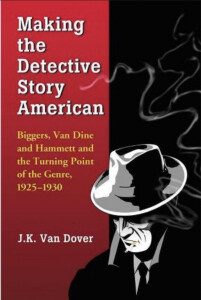 The past decade has witnessed a dark flowering of detective stories in genre fiction, from the Harry Dresden series to the more recent “weird-boiled noir” of Paul Tremblay’s The Little Sleep and China Mieville’s The City & the City, not to mention the proliferation of graphic novels such as the Eisner award-winning Criminal by Ed Brubaker.
The past decade has witnessed a dark flowering of detective stories in genre fiction, from the Harry Dresden series to the more recent “weird-boiled noir” of Paul Tremblay’s The Little Sleep and China Mieville’s The City & the City, not to mention the proliferation of graphic novels such as the Eisner award-winning Criminal by Ed Brubaker.
From the vantage of the early twenty-first century, the character of the detective or private investigator seems familiar – perhaps almost archetypal – even in its supernatural guise. Male or female, the PI is always tough, wise-cracking, and possessed of a strongly held (if not always entirely unambiguous) personal code, with the stories set against the backdrop of the dark and twisted streets of some American city. Raymond Chandler provided the definitive description of the character in The Simple Art of Murder: “But down these mean streets a man must go who is not himself mean, who is neither tarnished nor afraid.”
Yet, when that description was published in 1950, the PI was still in his salad days, barely twenty-five years old. In Making the Detective Story American: Biggers, Van Dine and Hammett and the Turning Point of the Genre, 1925-1930, J. K. Van Dover traces the evolution of the American detective story from its early roots, which were strongly patterned upon the English detective novel, to the recognizably American PIs of Dashiell Hammett. Van Dover further narrows the focus of his examination by concentrating on three writers: Willard Wright (who wrote under the pen name of S. S. Van Dine), creator of the Philo Vance novels; Earl Derr Biggers, author of the Charlie Chan novels; and Dashiell Hammett, author of the novels featuring the Continental Op and Sam Spade, the latter being what many consider to be the iconic American PI.
As Van Dover explains in the introduction to Making the Detective Story American, “even through the first decade of the twentieth century, much of the best in American art and literature was patterned upon English arts and letters …” Willard Wright and Earle Biggers, both educated at Harvard, attempted to create more distinctly American characters who lived in recognizably American cities. Willard Wright would create the polymath, art collector, and Manhattan intellectual Philo Vance. Earl Derr Biggers would create the Chinese-American Honolulu detective Charlie Chan, while Dashiell Hammett, the former Pinkerton agent, would create a number of PIs who spoke in American slang, smoked American cigarettes, and were often seduced and betrayed by American women.
Both of the first two characters have lost favor and come close to being forgotten by all but the most die-hard fans of Golden Age Detective fiction, and Van Dover does a fine job of exploring the cultural reasons for this disregard for what was once two bestselling series. Philo Vance came to seem somewhat dated due to his pretentious mode of speaking, his pedantic lectures on science and art and – unlike his English counterpart, Lord Peter Wimsey – his lack of any emotional or psychological development. Yet Van Dover does a fine job of using the character of Philo Vance to illustrate the tensions that came to be expressed in the culture of the 1920s, including the tension between the Victorian generation and the “lost generation.”
Van Dover’s exploration of the Charlie Chan novels also proves to be interesting for the cultural tensions it reveals.
When Earl Derr Biggers introduced Charlie Chan to the readers of The Saturday Evening Post in 1925, he was, in a decade of revulsion against ethnicity, introducing a hero whose ethnicity had been officially declared undesirable in America for more than four decades.
Indeed, Van Dover points out that the only fictional Chinese character familiar to most American readers and filmgoers up to that point was the infamous Fu Manchu, and at least one well-known set of rules regarding detective fiction written by Ronald A. Knox listed rule five as there should be no Chinese characters in the story. Biggers was not only to defy this rule but would, in his way, attempt to create a sympathetic and relatively complex character who would at times feel torn between his Chinese and American cultures.
Other topics explored in Making the Detective Story American include the use of real crime cases in detective fiction (these crimes would often manifest changing social attitudes toward new money and new sexual mores) and images of young women in detective fiction.
Various appendices provide further information on the three authors and their works. Appendix A offers brief individual biographies on Wright, Biggers, and Hammett. Appendix B provides lists of bestsellers for 1925-1935, while Appendix C lists films based upon the works of the three writers. There is also chapter notes and a five-page bibliography.
Making the Detective Story American is relatively clear and concise (excluding the index, the book totals under two hundred and twenty pages), with most of the work accessible to the general reader, although an interest in the cultural critics and literary lions of the early twentieth century is helpful. Some readers may be disappointed that Wright and Biggers seem to get the lion’s share of the text, with much less written about Hammett. On the other hand, there is no shortage of books and journal articles written about Hammett, and the bibliography provides a good resource for identifying some of those works. The narrow focus may also make this book of limited interest to some fans of detective fiction, but for those searching for the literary and cultural influences that helped to shape American detective fiction, Making the Detective Story American is well worth reading.
(McFarland, 2010)
